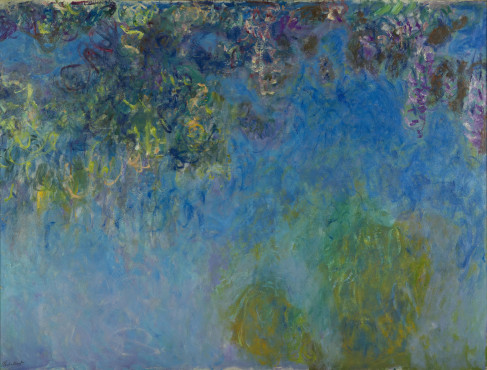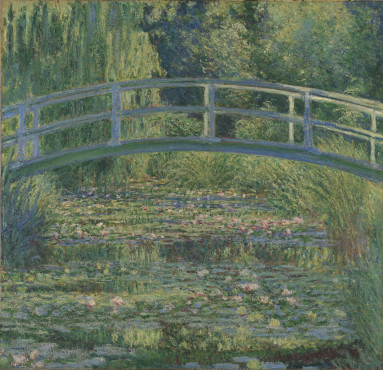
Monet’s famous paintings of his water lilies would almost not have existed. When Monet moved to Giverny, France in 1883, his neighbours heavily opposed his desire to build a water plant nursery in his backyard. Luckily for Monet, and for all who have had a chance to behold his paintings, the municipality of Giverny allowed the building of the nursery, resulting in him making over a hundred paintings of his beloved plants and flowers.

Claude Monet (1840-1926), Water lilies, 1916-1919, Musée Marmottan / Kunstmuseum Den Haag
The website of Kunstmuseum Den Haag tells me that the English name of the Monet exhibition is The Garden Paintings. This, to me, seems like a rather weak translation of the Dutch name: Tuinen van Verbeelding. Playing upon your imagination is exactly what Monet does with the painting of his backyard in Giverny. With the use of the softest colors and the details of the reflections in the shimmering water, Monet takes you with him to a hazy spring day where you are almost able to smell the flourishing water lilies he depicted.

Claude Monet (1840-1926), Wisteria, 1917-1920, Kunstmuseum Den Haag / Kunstmuseum Den Haag
As if in a dream, the exhibition allows you to wander from painting to painting, wishing you were back in the French countryside of the 1890s. The story goes that Monet was able to see ultraviolet light after he was operated on for cataracts, which led to the lens of his left eye being completely removed. It is not hard to believe that he was indeed able to see this light, because the colours that are used by Monet look like colours you’ve never seen before. The vibrating blue, soft pink and powdery lilac luminate from the canvasses. Where Monet’s painting style was more impressionist at first, he started to paint in an expressionist way during his years in Giverny. It was not about painting his garden as true as possible, but about capturing the beauty and feeling of timelessness this landscape breathed. In his later work, it becomes almost impossible to distinguish where the water ends and the sky begins.

Claude Monet (1840-1926), The water lily pond, 1899, National Gallery London / Kunstmuseum Den Haag
Walking through the exhibition I found myself longing for long, lazy spring days in the garden of my childhood home, doing nothing but reading a book and looking at the clouds passing by in the sky, whilst the sun is warming up my skin. Let yourself get lost and celebrate the beauty that Monet saw in front of his eyes, finding yourself wishing you could move to Giverny all at once to experience this breathtaking landscape.
The exhibition The Garden Paintings was on display until February 2nd, 2019 at Kunstmuseum Den Haag.
Monet’s famous paintings of his water lilies would almost not have existed. When Monet moved to Giverny, France in 1883, his neighbours heavily opposed his desire to build a water plant nursery in his backyard. Luckily for Monet, and for all who have had a chance to behold his paintings, the municipality of Giverny allowed the building of the nursery, resulting in him making over a hundred paintings of his beloved plants and flowers.

Claude Monet (1840-1926), Water lilies, 1916-1919, Musée Marmottan / Kunstmuseum Den Haag
The website of Kunstmuseum Den Haag tells me that the English name of the Monet exhibition is The Garden Paintings. This, to me, seems like a rather weak translation of the Dutch name: Tuinen van Verbeelding. Playing upon your imagination is exactly what Monet does with the painting of his backyard in Giverny. With the use of the softest colors and the details of the reflections in the shimmering water, Monet takes you with him to a hazy spring day where you are almost able to smell the flourishing water lilies he depicted.

Claude Monet (1840-1926), Wisteria, 1917-1920, Kunstmuseum Den Haag / Kunstmuseum Den Haag
As if in a dream, the exhibition allows you to wander from painting to painting, wishing you were back in the French countryside of the 1890s. The story goes that Monet was able to see ultraviolet light after he was operated on for cataracts, which led to the lens of his left eye being completely removed. It is not hard to believe that he was indeed able to see this light, because the colours that are used by Monet look like colours you’ve never seen before. The vibrating blue, soft pink and powdery lilac luminate from the canvasses. Where Monet’s painting style was more impressionist at first, he started to paint in an expressionist way during his years in Giverny. It was not about painting his garden as true as possible, but about capturing the beauty and feeling of timelessness this landscape breathed. In his later work, it becomes almost impossible to distinguish where the water ends and the sky begins.

Claude Monet (1840-1926), The water lily pond, 1899, National Gallery London / Kunstmuseum Den Haag
Walking through the exhibition I found myself longing for long, lazy spring days in the garden of my childhood home, doing nothing but reading a book and looking at the clouds passing by in the sky, whilst the sun is warming up my skin. Let yourself get lost and celebrate the beauty that Monet saw in front of his eyes, finding yourself wishing you could move to Giverny all at once to experience this breathtaking landscape.
The exhibition The Garden Paintings was on display until February 2nd, 2019 at Kunstmuseum Den Haag.


